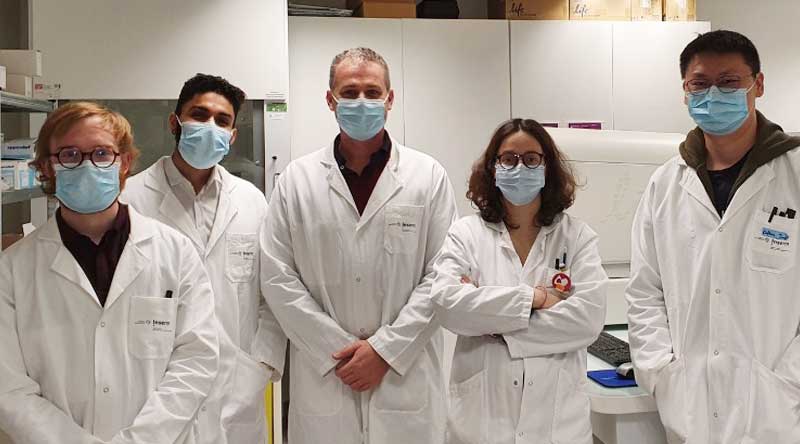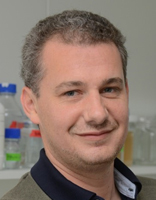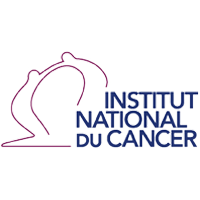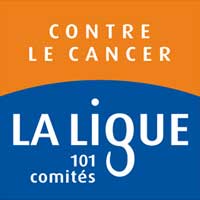Genetic and Epigenetic control of Normal and Malignant Hematopoiesis
Genetic and Epigenetic control of Normal and Malignant Hematopoiesis
MEMBERS
Jiang HU Postdoc
jiang.hu@inserm.fr
Yannis BELLOUCIF PdH student
yannis.bellousif@inserm.fr
Paul-Arthur MESLIN M2 Bioninformatics student
paul-arthur.meslin@inserm.fr
OUR PARTNERS

Addressing non-coding genome functions in Acute Myeloid Leukemia
Acute Myeloid Leukemia (AML) is the most common acute leukemia diagnosed in adults and is accounted for approximately 25,000 new diagnosed cases per year in Europe. Despite the use of chemotherapy and stem cell transplantation, AML has a dismal overall 5-year survival of 24% and almost 50% of AML patients relapse after treatment. Currently, there are no targeted therapies for this disease making the study of the molecular mechanisms of its induction and progression of biologic and clinical significance. To date most efforts in understanding AML induction and progression have focused on the protein-coding genome, which in humans represents less than 2% of all our genetic material. Non-coding regions in the genome play an important role in regulating gene transcription. These regions encompass insulators, enhancers and non-coding RNA. We believe that the study of these non-coding elements could help decipher complex coordinated gene expression programs that lead to oncogenesis and help design novel targeted therapies for the treatment of this disease.
Our team focuses on two main axes of research:
Study of Super Enhancers dysregulation in the pathogenesis of AML
Recently, Super Enhancers (SE) have been characterized as single or group of enhancers with unusual strong enrichment for binding of transcriptional co-activators and strong modifications of histone tails. SE can be virtually defined in any cell type and tend to be highly cell type specific. Cancer cells often present with altered gene expression patterns and enhancer usage compared to their normal counterparts. Particularly, SE tend to be enriched around and control genes known to play oncogenic functions. Our results show that SE profiles and activity are depending on oncogenic lesions and particularly that fusion oncogenes can hijack genomic regions to create aberrant de novo SE inducing oncogenes upregulation. We use combinations of genome wide transcriptomic and epigenomic approaches together with high throughput screening technologies based on CRISPR/Cas9, shRNA and CRISPRi to interrogate SE functions and their importance in transcription regulation and leukemia progression.
Discovery and functional characterization of long non-coding RNA in Acute Myeloid Leukemia
The human transcriptome is composed not only of protein-coding mRNA, but also a significant proportion of non-coding RNA (ncRNA). This finding has challenged the central dogma of molecular biology as ncRNAs do not act as intermediates between DNA and peptide, but rather function as regulatory molecules. Long non-coding RNAs (lncRNA) have recently become an attractive area of study as whole-transcriptome data has shown that their cellular abundance may be similar or even higher than that of mRNA and their expression appears to be highly tissue specific. Importantly, one of the key functions of lncRNA is to target chromatin modifiers to specific loci. Several reports have implicated lncRNAs in the regulation of oncogene and tumor suppressor transcription in cancer. Using RNA-sequencing in primary AML patients and AML model cell lines we have identified thousands of lncRNA. Using functional genomic approaches and molecular biology we try to delineate the function of these transcript in AML and whether they could be used as therapeutic targets or novel biomarkers to help stratify AML patients.
We are looking for highly motivated Post-doc fellows to work on Super Enhancers in Acute Myeloid leukemia.
►Benbarche S, Lopez CK, Salataj E, Aid Z, Thirant C,Laiguillon MC, Lecourt S, Belloucif Y, Vaganay C, Antonini M, Hu J, da Silva Babinet A, Ndiaye-Lobry D, Pardieu B, Petit A,Puissant A, Chaumeil J, Mercher T and Lobry C. (2022) Screening of ETO2-GLIS2 induced Super Enhancers identifies targetable cooperative dependencies in acute megakaryoblastic leukemia. Sci Adv. 2022 Feb 9; 8(6):eabg9455. doi : 10.1126/sciadv.abg9455.
►Belloucif Y and Lobry C. (2022) Super-Enhancers Dysregulations in Hematological Malignancies. Cells 2022 Jan 7;11(2):196. doi: 10.3390/cells11020196.
► Xiong H, Mancini M, Gobert M, Shen S, Furtado GC, Lira SA, Parkhurst CN, Garambois V, Brengues M, Tadokoro CE, Trimarchi T, Gómez-López G, Singh A, Khiabanian H, Minuzzo S, Indraccolo S, Lobry C, Aifantis I, Herranz D, Lafaille JJ, Maraver A. (2021) Spleen plays a major role in DLL4-driven acute T-cell lymphoblastic leukemia. Theranostics. 2021; 11(4):1594-1608. doi: 10.7150/thno.48067. eCollection 2021
► Su A, Ling F, Vaganay C, Pardieu B, Benajiba L, Sodaro G, Pasanisi J, Lin KH, Rutter JC, Bassil CF, Antony-Debré I, Alexe G, Benoist JF, Pikman Y, Qi J, Dombret H, Preudhomme C, Fenouille N, Golan HM, Stegmaier K, Lobry C*, Wood KC*, Itzykson R* and Puissant A*. (2020) The folate cycle enzyme MTHFR is a critical regulator of cell response to MYC-targeting therapies. Cancer Discov 2020 Aug 21. doi: 10.1158/2159-8290. CD-19-0970. Online ahead of print.
*Co-senior authors
► Lopez, C. K., Noguera, E., Stavropoulou, V., Robert, E., Aid, Z., Ballerini, P., Bilhou-Nabera, C., Lapillonne, H., Boudia, F., Thirant, C., Fagnan, A., Arcangeli, M. L., Kinston, S. J., Diop, M., Job, B., Lecluse, Y., Brunet, E., Babin, L., Villeval, J. L., Delabesse, E., Peters, A., Vainchenker, W., Gaudry, M., Masetti, R., Locatelli, F., Malinge, S., Nerlov, C., Droin, N., Lobry, C., Godin, I., Bernard, O. A., Gottgens, B., Petit, A., Pflumio, F., Schwaller, J. & Mercher, T. (2019) Ontogenic Changes in Hematopoietic Hierarchy Determine Pediatric Specificity and Disease Phenotype in Fusion Oncogene-Driven Myeloid Leukemia. Cancer Discov 9, 1736-1753, doi:10.1158/2159-8290. CD-18-1463.
► Lobry, C., Bains, A., Zamechek, L. B., Ibrahim, S., Aifantis, I. & Araten, D. J. (2019) Analysis of TET2 mutations in paroxysmal nocturnal hemoglobinuria (PNH). Exp Hematol Oncol 8, 17, doi:10.1186/s40164-019-0142-0.
► Bencheikh, L., Diop, M. K., Riviere, J., Imanci, A., Pierron, G., Souquere, S., Naimo, A., Morabito, M., Dussiot, M., De Leeuw, F., Lobry, C., Solary, E. & Droin, N. (2019) Dynamic gene regulation by nuclear colony-stimulating factor 1 receptor in human monocytes and macrophages. Nat Commun 10, 1935, doi:10.1038/s41467-019-09970-9.
► Benbarche, S., Lopez, C. K., Salataj, E., Thirant, C., Laiguillon, M.-C., Aid, Z., Lecourt, S., Antonini, M., Pardieu, B. Petit, A., Puissant, A., Chaumeil, J., Mercher, T., Lobry, C. (2019) Screening of clustered regulatory elements reveals functional cooperating dependencies in Leukemia. bioRxiv, 680,165. Under Review
► Zajac, O., Raingeaud, J., Libanje, F., Lefebvre, C., Sabino, D., Martins, I., Roy, P., Benatar, C., Canet-Jourdan, C., Azorin, P., Polrot, M., Gonin, P., Benbarche, S., Souquere, S., Pierron, G., Nowak, D., Bigot, L., Ducreux, M., Malka, D., Lobry, C., Scoazec, J. Y., Eveno, C., Pocard, M., Perfettini, J. L., Elias, D., Dartigues, P., Goere, D. & Jaulin, F. (2018) Tumour spheres with inverted polarity drive the formation of peritoneal metastases in patients with hypermethylated colorectal carcinomas. Nat Cell Biol 20, 296-306, doi:10.1038/s41556-017-0027-6.
► Valls, E.*, Lobry, C.*, Geng, H., Wang, L., Cardenas, M., Rivas, M., Cerchietti, L., Oh, P., Yang, S. N., Oswald, E., Graham, C. W., Jiang, Y., Hatzi, K., Agirre, X., Perkey, E., Li, Z., Tam, W., Bhatt, K., Leonard, J. P., Zweidler-McKay, P. A., Maillard, I., Elemento, O., Ci, W., Aifantis, I. & Melnick, A. (2017) BCL6 Antagonizes NOTCH2 to Maintain Survival of Human Follicular Lymphoma Cells. Cancer Discov 7, 506-521, doi:10.1158/2159-8290. CD-16-1189.
*These authors contributed equally to the work
► Thirant, C., Ignacimouttou, C., Lopez, C. K., Diop, M., Le Mouel, L., Thiollier, C., Siret, A., Dessen, P., Aid, Z., Riviere, J., Rameau, P., Lefebvre, C., Khaled, M., Leverger, G., Ballerini, P., Petit, A., Raslova, H., Carmichael, C. L., Kile, B. T., Soler, E., Crispino, J. D., Wichmann, C., Pflumio, F., Schwaller, J., Vainchenker, W., Lobry, C., Droin, N., Bernard, O. A., Malinge, S. & Mercher, T. (2017) ETO2-GLIS2 Hijacks Transcriptional Complexes to Drive Cellular Identity and Self-Renewal in Pediatric Acute Megakaryoblastic Leukemia. Cancer Cell 31, 452-465, doi:10.1016/j.ccell.2017.02.006.
► Proudhon, C., Snetkova, V., Raviram, R., Lobry, C., Badri, S., Jiang, T., Hao, B., Trimarchi, T., Kluger, Y., Aifantis, I., Bonneau, R. & Skok, J. A. (2016) Active and Inactive Enhancers Cooperate to Exert Localized and Long-Range Control of Gene Regulation. Cell Rep 15, 2159-2169, doi:10.1016/j.celrep.2016.04.087.
► Lee, S. C., Dvinge, H., Kim, E., Cho, H., Micol, J. B., Chung, Y. R., Durham, B. H., Yoshimi, A., Kim, Y. J., Thomas, M., Lobry, C., Chen, C. W., Pastore, A., Taylor, J., Wang, X., Krivtsov, A., Armstrong, S. A., Palacino, J., Buonamici, S., Smith, P. G., Bradley, R. K. & Abdel-Wahab, O. (2016) Modulation of splicing catalysis for therapeutic targeting of leukemia with mutations in genes encoding spliceosomal proteins. Nat Med 22, 672-678, doi:10.1038/nm.4097.
► Lobry, C. (2015) Restoring Ikaros’s wings to solve a leukemia maze. Blood 126, 1735-1736, doi:10.1182/blood-2015-08-662544.
► Kim, E., Ilagan, J. O., Liang, Y., Daubner, G. M., Lee, S. C., Ramakrishnan, A., Li, Y., Chung, Y. R., Micol, J. B., Murphy, M. E., Cho, H., Kim, M. K., Zebari, A. S., Aumann, S., Park, C. Y., Buonamici, S., Smith, P. G., Deeg, H. J., Lobry, C., Aifantis, I., Modis, Y., Allain, F. H., Halene, S., Bradley, R. K. & Abdel-Wahab, O. (2015) SRSF2 Mutations Contribute to Myelodysplasia by Mutant-Specific Effects on Exon Recognition. Cancer Cell 27, 617-630, doi:10.1016/j.ccell.2015.04.006.
► Cimmino, L., Dawlaty, M. M., Ndiaye-Lobry, D., Yap, Y. S., Bakogianni, S., Yu, Y., Bhattacharyya, S., Shaknovich, R., Geng, H., Lobry, C., Mullenders, J., King, B., Trimarchi, T., Aranda-Orgilles, B., Liu, C., Shen, S., Verma, A. K., Jaenisch, R. & Aifantis, I. (2015) TET1 is a tumor suppressor of hematopoietic malignancy. Nat Immunol 16, 653-662, doi:10.1038/ni.3148.
► Lobry, C. Oh, P., Mansour, M. R., Look, A. T. & Aifantis, I. (2014) Notch signaling: switching an oncogene to a tumor suppressor. Blood 123, 2451-2459, doi:10.1182/blood-2013-08-355818.
► Gough, D. J., Marie, I. J., Lobry, C., Aifantis, I. & Levy, D. E. (2014) STAT3 supports experimental K-RasG12D-induced murine myeloproliferative neoplasms dependent on serine phosphorylation. Blood 124, 2252-2261, doi:10.1182/blood-2013-02-484196.
► Oh, P.*, Lobry, C.*, Gao, J., Tikhonova, A., Loizou, E., Manet, J., van Handel, B., Ibrahim, S., Greve, J., Mikkola, H., Artavanis-Tsakonas, S. & Aifantis, I. (2013) In vivo mapping of notch pathway activity in normal and stress hematopoiesis. Cell Stem Cell 13, 190-204, doi:10.1016/j.stem.2013.05.015.
*These authors contributed equally to the work
► Lobry, C.*, Ntziachristos, P., Ndiaye-Lobry, D., Oh, P., Cimmino, L., Zhu, N., Araldi, E., Hu, W., Freund, J., Abdel-Wahab, O., Ibrahim, S., Skokos, D., Armstrong, S. A., Levine, R. L., Park, C. Y. & Aifantis, I#. (2013) Notch pathway activation targets AML-initiating cell homeostasis and differentiation. J Exp Med 210, 301-319, doi:10.1084/jem.20121484.
*Co-coresponding authors
Marion ANTONINI
M1 Student
Elsa BARREAU
M1 Student
Salima BENBARCHE
Postdoc
Lauriane CHALON
M2 Student
Kathleen FLOSSEAU
Research Technician
Chiara GLEN
International Bachelor Student (Neetherlands)
Camille GONZALES
M1 Student
Sarah KALFA
IUT Student
Marie-Charlotte LAIGUILLON
Postdoc
Séverine LECOURT
IR Université Paris Sud
Hélène LEDDEN-HASSE
Research Engineer
Samia OUSSOUS
L3 Summer Student
Imène RÉSINE
M2 Médical Student
Mirjam STRANZL
International Bachelor Student (Luxembourg)
Elsa SALLES
L3 Summer Student
Julie THÉVENOT
M1 Student






